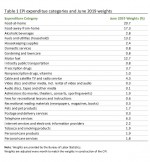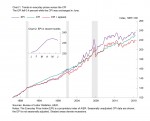Grocery and Restaurant Prices Offset in the AIER Everyday Price Index

AIER’s Everyday Price Index fell 0.4 percent in June reversing a 0.4 percent rise in May. The more widely known price gauge, the Consumer Price Index was unchanged in June. The EPI measures price changes people see in everyday purchases such as groceries, restaurant meals, gasoline, and utilities. The EPI is not seasonally adjusted, so we compare it with the unadjusted CPI. The EPI including apparel, a broader measure, also fell 0.4 percent in June as apparel prices dropped 0.5 percent for the month. Both measures exclude prices of infrequently purchased, big-ticket items (such as cars, appliances, and furniture) and prices contractually fixed for prolonged periods (such as housing).
Over the past 12 months, the EPI has risen just 0.1 percent while the EPI including apparel is flat. The Consumer Price Index is up 1.6 percent over the past 12 months. Over the last five years, the EPI is up at a 0.1 percent annualized rate while the EPI including apparel in essentially unchanged and the consumer price index is up at a 1.5 percent annualized pace.
The two major components of food prices, food at home (groceries) and food away from home (primarily restaurants) continued the recent trends of faster price increases for restaurants and weaker prices for groceries. The two categories posted offsetting results in June, on a not-seasonally-adjusted basis, with groceries falling 0.3 percent while restaurants rose 0.3 percent. Over the last 12 months, grocery prices are up just 0.9 percent while restaurant prices are up 3.1 percent; the five-year annualized gains were 0.2 percent and 2.7 percent, respectively. The diverging trends may reflect the higher labor component of restaurants.
Energy continued to be a major driver of the Everyday Price index. Within the broad energy category, motor fuel prices fell 4.9 percent for the month following four consecutive increases. Household fuels and utilities however rose 1.4 percent for the month, the second gain in a row. Other categories had very small contributions in June.
Over the past year, three-fourths of the categories that make up the EPI have posted higher prices, with 9 categories showing a rise of less than 2 percent and 9 showing gains greater than 2 percent. Six of the categories show price declines over the past year. Among the largest gainers and decliners over the past year, prescription drug prices are down 2.0 percent, telephone-services prices are down 1.7 percent, and apparel prices are down 1.3 percent from a year ago while postage and delivery services are up 5.5 percent, tobacco and smoking products are up 4.6 percent, recreational reading materials are up 3.6 percent, fees for lessons are up 3.5 percent, and as previously mentioned, restaurants are up 3.1 percent.
Among the components with the largest weights in the EPI, as already mentioned, food at home (20.7 percent weight) is up 0.9 percent from a year ago while food away from home (17.3 percent) is up 3.1 percent, household fuels and utilities (13.2 percent) are up 0.1 percent for the year, and motor fuel (12.7 percent) is down 5.4 percent since last June. Combined, they account for 63.9 percent of the EPI.







